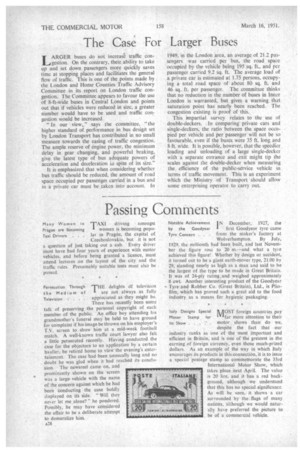The Case For Larger Buses
Page 30

If you've noticed an error in this article please click here to report it so we can fix it.
IARGER buses do not increase traffic conI gestion. On the contrary, their ability to take up and set down passengers more quickly saves time at stopping places and facilitates the general flow of traffic. This is one of the.points made by the London and Home Counties Traffic Advisory Committee in its report on London traffic congestion. The Committee appears to favour the use of 8-ft-wide buses in Central London and points out that if vehicles were reduced in size, a greater number would have to be used and traffic congestion would be increased.
" In our view," says the committee, "the higher standard of performance in bus design set by London Transport has contributed in no small measure towards the easing of traffic congestion. The ample reserve of engine power, the minimum delay in gear changing, and powerful braking. give the latest type of bus adequate powers of acceleration and deceleration in spite of its size."
It is emphasized that when considering whether bus traffic should be reduced, the amount of road space occupied per passenger carried in a bus and in a private car must be _taken into account. In
1949, in the London area, an average of 21.2 passengers was carried per bus, the road space occupied by the vehicle being 195 sq ft., and per passenger carried 9.2 sq. ft. The average load of a private car is estimated at 1.75 persons, occupyine a total road space of about 80 sq. ft. and 46 sq. ft. per passenger. The committee thinks that no reduction in the number of buses in Inner London is warranted, but gives a warning that saturation point has nearly been reached. The congestion existing is proof of this.
This impartial survey relates to the use of double-deckers. In comparing private cars and single-deckers, the ratio between the space occupied per vehicle and per passenger will not be so favourable, even if the buses were 35 ft. long and 8 ft. wide. It is possible, however, that the speedier loading and unloading of a large single-decker with a separate entrance and exit might tip the scales against the double-decker when measuring the efficiency of the public-service vehicle in terms of traffic movement. This is an experiment which the Ministry of Transport should allow some enterprising operator to carry out.




















































































